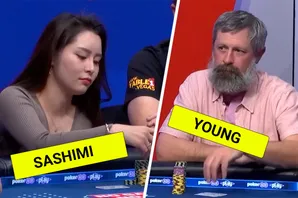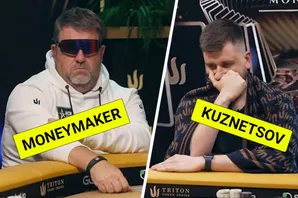EV is expected value. It has long been a common term in poker and is now more widely used outside of the game’s community as well.
In its most basic usage, EV is the value of your decision in a poker hand or situation over time. It is the likelihood that the decision would lead to either a positive or negative result if made repeatedly.
Poker is generally accepted as a game of skill and luck, but where skill can outweigh luck in the long run rather than the short term. This is because of decisions based on positive expected value, also known as positive EV or +EV. Players who study poker can calculate EV in any particular hand in most cases and determine whether a decision has a positive or negative EV.
EV is not the only factor used in making positive EV decisions — not by a long shot. But EV is a good baseline for decision-making. It provides the mathematical analysis: the odds of a decision working out in a particular way over time. A player can then use that information to play better poker.
What is a good EV in poker?
Good EV or positive EV in poker is a decision that has a positive result in the long run. If you make that decision in various situations multiplied by hundreds or thousands of instances, and it creates a positive end result, that decision is +EV even if in isolated moments the result is negative.
The best example is preflop pocket aces. They’re the best starting hand in Texas hold’em. Pocket aces will win 85% of the time against another hand (in heads-up poker). Against a table full of other poker players, aces still hold positive equity of 35%. This is positive EV.
Of course, another hand will crack those aces from time to time. You may even lose with pocket aces several times in a row, though the odds of that happening are low. But over time, those pocket aces have more than 20 times the expected value of most other solid starting hands.
Good EV is anything over 50%. While other factors influence poker decisions, good EV should be one of the most important ones.
The EV poker formula
The EV formula itself is fairly simple. To calculate it, multiply the percentage of times you can win by the amount of money you can win. From that, subtract the percentage of times you can lose by the amount of money you can lose.
- EV = % win rate x $ to win (minus) % of loss rate to $ to lose
The formula becomes a bit more complicated when calculating EV in a single poker hand. The money you could win or lose includes the amount of the bet or raise, the amount required to call, and knowledge of the amount of money in the pot or pot size.
Remember that the money that you may lose can’t include the blinds and antes. That money is already in the pot and isn’t considered part of the calculation.
Most people use an equity calculator to figure out the percentage of time they may win a hand. Eventually, skilled players understand these basic calculations without a calculator. You should consider the most likely hands your opponent holds — also known as their hand ranges — so you can find the equity in playing your cards against them. You can use that to calculate your win rate.
+EV vs. -EV
When the “win” part of the equation is greater than the “loss” part, the best possible outcome is a positive dollar amount. This makes it a +EV or positive EV situation. Positive EV means that the player should call the bet or raise, because they have a better chance of winning money in the hand.
If the loss potential is greater than the win potential, the move is a -EV one. While we can make some arguments in favor of calling under special circumstances, a negative EV play is one with a negative expected value. That indicates the player should fold on that bet.
As for special circumstances, other factors can sometimes come into play. Your opponent may have a short stack and seem like they want to exit the poker game. They may take more chances with their hand than the typical charts may indicate. They may also be tilted or otherwise mentally compromised, giving you an additional reason to call.
+EV vs. Optimal
“Optimal” play is a modern poker concept, often referred to as Game Theory Optimal (GTO). It’s a defensive strategy that assumes your opponent is playing less than optimally. Your strategy is then based on playing optimal poker vs an opponent who may be making mistakes.
When you use GTO, you gather information about your opponent’s actions to determine their hand ranges, which are the assortment of hands that they may play a particular way or in certain situations. Playing optimally against them requires an analysis of their plays and considering the best strategies to use against them.
In any given hand, the optimal play can determine the EV. In this way, GTO and EV cross paths to work toward the best possible scenario. Combining both strategies can give you the upper hand because you’re both playing optimally and seeking positive EV.
When optimal analysis shows negative EV in a particular situation, you can still play the GTO method by the exact numbers, but lining up GTO play with EV gives a firmer answer about how to play a certain hand or how to play against a particular player.
In online poker, EV is easier to calculate. In live poker, however, players can often determine optimal plays more quickly than EV and use it accordingly.
Using expected value at the poker table
New players should take time to study poker EV and practice doing quick calculations. A player should be fairly well versed in the EV formula and know how to quickly calculate percentages and other figures so they don’t become confused at the poker table. In addition, taking too long to calculate EV and move on with your play may indicate to an opponent that you’re a new player and prone to mistakes.
It’s best to make EV calculations and build your poker strategy at online tables. You can use solvers or even a basic calculator to determine whether a hand has positive EV or negative expected value. This hones your skills in private before taking the concept to poker tables in casinos.
You should avoid spending too much time working on EV formulas at live poker tables. Too much head-scratching can frustrate other players and the dealers. Using the Rule of Two and Four below can help you use estimates and broad calculations to make quicker decisions and keep the game moving. With practice, your EV calculations can speed up, avoiding uncomfortable delays.
Note that there are often several EV calculations in play. With options such as checking, betting, or raising, you should calculate several possible EV situations in order to determine the best one.
EV and strategic betting
Expected value is a factor in determining bet sizing and moves.
When you can calculate EV quickly and determine one or more +EV moves, you can adjust your bets to maximize those moves.
If you’re certain that you hold the best hand, you can bet small to try to persuade your opponent to call with a suboptimal hand. You should also consider making this move if you’re unsure about your player’s hole cards. A small bet can provide an opportunity for the opponent to make a move that more accurately indicates their hand strength or hand weakness.
The most common way to use EV in betting strategy is to determine whether to bet or check. You should be able to determine the expected value in both options. Sometimes, both values will be the same and the final calculations will dictate a bet or check.
For example, if the win percentage and loss percentage equal 100% but are quite close, the player needs to make a judgment call on the spot. Most often, the formula will determine the playability of the hand and the proper way to respond. Sometimes, that is a check-raise, and other times it could be a complete fold.
The beauty of poker is the skill factor and the need to keep learning.
What is the fastest way to calculate expected value?
The formula to calculate expected value is simple and straightforward, but it can be difficult to calculate EV in the moment while you’re at the poker table. It takes practice and experience to do it fast, so you don’t disrupt the play.
Many new players simply use the Rule of 2 and 4 to get an approximate expected value. The rule requires you to simply know your outs. If you’re looking for a flush or straight, you should be able to calculate the number of cards in the deck that could make that happen.
Quite simply, multiply the number of outs required by two. Then add two to that number. For example, if you have a flush draw with nine outs, you should multiply that by two (to get 18) and add two (to get 20). That gives you approximately 20% equity in the hand.
If that hand equity is greater than the pot equity, you have +EV.
Recommended tools for using EV in poker
When practicing EV in online poker, it helps to use a solver. While most sites prohibit the use of solvers in regular gameplay, they’re a good way to learn the concepts and practice them.
The most commonly used EV programs include versions of Holdem Manager, Poker Tracker, and PokerSnowie. Some software can be expensive, so new players often share the cost with each other. However, even for one player, a solver is an investment in poker knowledge that can pay off in the future.
Some online poker sites like PokerStars and 888poker also offer solver tools. These can help with everything from basic pot odds to bluff equity and fold equity. Even some of the basic information in an educational poker program is helpful, such as the ability to see chip stacks in big blinds instead of larger numbers.
The takeaway
Expected value is a way to make better, more profitable decisions in poker, so you can maximize profits in the long term.
Making positive EV plays reduces your overall variance in poker. It keeps you from using instincts that may not always be correct, replacing those poor decisions with mathematically sound ones. EV doesn’t protect players from bad beats, but it does reduce their frequency.
The expected value calculation is also a tool to help players improve their overall understanding of the game. It can increase profits and reduce variance for long-term players who want to make the most of their poker experiences. Learn to use EV well, and you’ll be on your way to becoming a winning poker player.
Featured image source: Flickr by Kat used under CC license
































